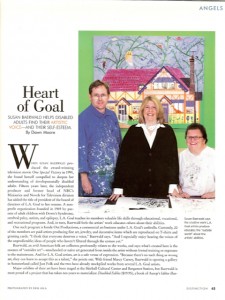 WHEN SUSAN BAERWALD PRODUCED THE AWARD-WINNING TELEVISION MOVIE One Special Victory in 1991, she found herself compelled to deepen her understanding of developmentally disabled adults. Fifteen years later, the independent producer and former head of NBC’s Miniseries and Novels for Television division has added the title of president of the board of directors of L.A. Goal to her resume. A non- profit organization founded in 1969 by parents of adult children with Down’s Syndrome, cerebral palsy, autism, and epilepsy, L.A. Goal teaches its members valuable life skills through educational, vocational, and recreational programs. And, in turn, Baerwald feels the artists’ work educates others about their abilities.
WHEN SUSAN BAERWALD PRODUCED THE AWARD-WINNING TELEVISION MOVIE One Special Victory in 1991, she found herself compelled to deepen her understanding of developmentally disabled adults. Fifteen years later, the independent producer and former head of NBC’s Miniseries and Novels for Television division has added the title of president of the board of directors of L.A. Goal to her resume. A non- profit organization founded in 1969 by parents of adult children with Down’s Syndrome, cerebral palsy, autism, and epilepsy, L.A. Goal teaches its members valuable life skills through educational, vocational, and recreational programs. And, in turn, Baerwald feels the artists’ work educates others about their abilities.
One such program is Inside Out Productions, a commercial art business under L.A. Goal’s umbrella. Currently, 20 of the members are paid artists producing fine art, jewelry, and decorative items which are reproduced on T-shirts and greeting cards. “I think that everyone deserves a voice,” Baerwald says. “And I especially enjoy hearing the voices of the unpredictable; ideas of people who haven‘t filtered through the system yet.”
Baerwald, an avid American folk art collector, profoundly relates to the works, and says what’s created here is the essence of “outsider art” – unschooled or naive art generated from inside the artist without formal training or exposure to the mainstream. And for L.A. Goal artists, art is a safe venue of expression. “Because there’s no such thing as wrong art, they can learn to accept this as a talent,” she points out. With friend Marcy Carsey, Baerwald is opening a gallery in Summerland called Just Folk and the two have already stockpiled works from several L.A. Goal artists.
Major exhibits of their art have been staged at the Skirball Cultural Center and Bergamot Station, but Baerwald is most proud of a project that has taken ten years to materialize: Disabled Fables ($19.95), a book of Aesop’s fables illustrated and interpreted by 12 L.A. Goal artists. Inspired by the members’ interest in movie-making, Baerwald tried conveying the concept of storyboarding but was met with blank stares. Then she and the agency’s art teacher suggested illustrating The Tortoise and the Hare in four progressive images; light bulbs went off and a concept was born.
The book is a vibrant work with bold graphics, interpretive images, and deeply simple truths. “The publishers were hesitant to use Disabled in the title. We had to beg. I said, ‘No, no, the artists named it! Disabled is a statement of fact and they are very comfortable with that.’” Sean Penn, who visited the organization while researching his role in I Am Sam, wrote in the foreword that he was the disabled one working alongside L.A. Goal members.
Fund–raising for the agency has been challenging. There are no black-tie dinners with $1,000 seats, only the generosity of a small donor base. “It’s very hard, but occasionally you find someone wonderful like Wally Annenberg, who just gave us $50,000,” Baerwald reports. Sales of the members‘ art is not only the single most successful income-generating effort, but more importantly, raises the artist‘s self-esteem and offers them an opportunity to interact.
Baerwald bubbles with pride in all the L.A. Goal artists’ achievements. “I think what you take away from time with them is their sense of self-worth and dignity,” she says, “knowing they can feel important to themselves. It means so much more here.”